The Role of System Thinking in Australia's Ageing Workforce: Essay
VerifiedAdded on 2023/06/08
|8
|3046
|256
Essay
AI Summary
This essay delves into the critical issue of Australia's ageing workforce, framing it as a 'wicked problem' within the context of sustainability and system thinking. It highlights the demographic shifts, including declining birth rates and increasing life expectancies, leading to a growing proportion of older citizens. The essay analyzes the multifaceted impacts on the Australian economy, labor market, government expenditure, and social structures. It discusses the need for proactive policies, including migration strategies and adjustments to retirement ages, to mitigate the adverse effects. Furthermore, the study emphasizes the importance of system thinking as a framework for understanding the interconnectedness of various factors and developing comprehensive solutions. The essay concludes by advocating for long-term economic management, strategic thinking, and the implementation of the National Strategy for an Ageing Australia to address the challenges and ensure sustainable economic performance.
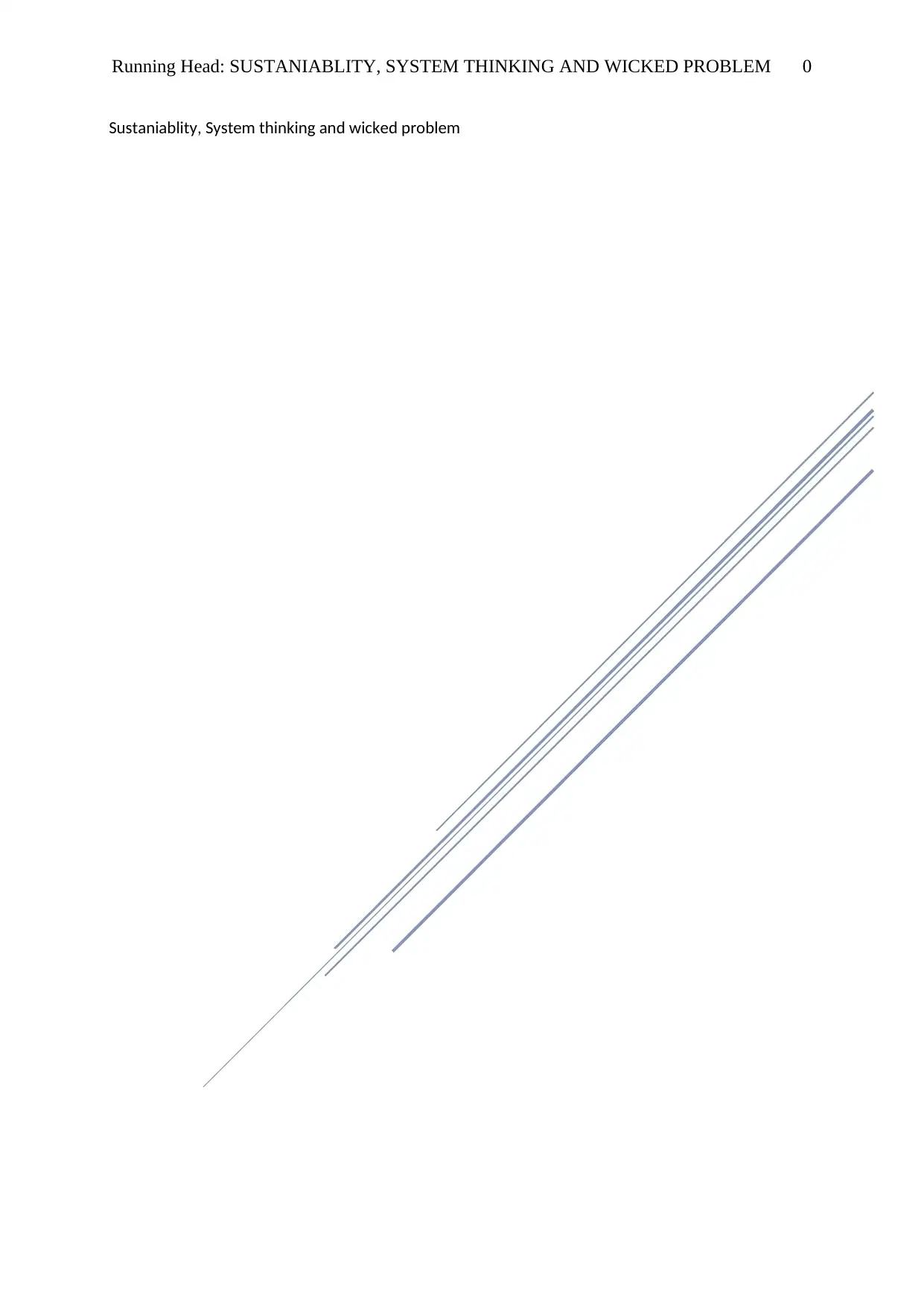
Running Head: SUSTANIABLITY, SYSTEM THINKING AND WICKED PROBLEM 0
Sustaniablity, System thinking and wicked problem
Sustaniablity, System thinking and wicked problem
Paraphrase This Document
Need a fresh take? Get an instant paraphrase of this document with our AI Paraphraser

SUSTANIABLITY, SYSTEM THINKING AND WICKED PROBLEM 1
Sustainability approach is a capacity of biological systems, which need to be productive and
dynamic in the long time period. The sustainability includes the principles for the
development having various interrelated areas like culture, economics, ecology and politics
(Jain and Jain, 2013). There are many issues evolving continuously and bringing a challenge
to the sustainability. From these various issues, many scholars and economist states some of
the issues as wicked problems as they cannot be appropriately defined and the final solutions
cannot be taken out. Due to this, the interest of all stakeholders here is optimal. The wicked
problem is always having complex approaches and algorithms with the dynamic changing
requirements. For anyone who wants to reach to a solution or develop any solution, it is
necessary to change the traditional way of thinking and improve the mental model (Weber
and Khademian, 2008). Therefore, the system thinking comes here which help an individual
or a business enterprise to develop a model, which can help in facing the solutions to the
sustainable challenges.
System thinking can be defined as an inter-disciplinary framework that is used to check the
interrelationships in the patterns of the elements and aspects rather than the static snapshots.
It also consists of people, structures and processes, which play a significant role in making a
business enterprise healthy or unhealthy (Ben and Orion, 2010). Even though system thinking
is a very old concept, it can help in understating the issue from various angles and achieve the
existing complex problems on both levels i.e. local and global. It is a procedure for
development planners to give their views towards systematic integration of economic and
socio-environmental dimensions of sustainability. This approach helps in leveraging
organisation complications as compared with other methods (Evagorou et al, 2009). System
thinking approach also helps in understanding the broader picture of the problem through
making interactions with various elements.
Through the study, it can be said as wicked problem never exists in isolation but it is
impacted by a vast system of interconnected networks and therefore, it plays an important
role in finding out the solutions for the problems (Head, 2008). In addition, the main
principles of system thinking are the emerging technologies, innovative and creative ideas,
leadership and human resource and these all help in removing the wicked problems.
The purpose of this essay is to find out the role of system thinking in the wicked problem
relating to Australia ageing workforce. This statement can be also agreeable that ‘system
thinking is important in planning keys for the sustainability challenges’.
Sustainability approach is a capacity of biological systems, which need to be productive and
dynamic in the long time period. The sustainability includes the principles for the
development having various interrelated areas like culture, economics, ecology and politics
(Jain and Jain, 2013). There are many issues evolving continuously and bringing a challenge
to the sustainability. From these various issues, many scholars and economist states some of
the issues as wicked problems as they cannot be appropriately defined and the final solutions
cannot be taken out. Due to this, the interest of all stakeholders here is optimal. The wicked
problem is always having complex approaches and algorithms with the dynamic changing
requirements. For anyone who wants to reach to a solution or develop any solution, it is
necessary to change the traditional way of thinking and improve the mental model (Weber
and Khademian, 2008). Therefore, the system thinking comes here which help an individual
or a business enterprise to develop a model, which can help in facing the solutions to the
sustainable challenges.
System thinking can be defined as an inter-disciplinary framework that is used to check the
interrelationships in the patterns of the elements and aspects rather than the static snapshots.
It also consists of people, structures and processes, which play a significant role in making a
business enterprise healthy or unhealthy (Ben and Orion, 2010). Even though system thinking
is a very old concept, it can help in understating the issue from various angles and achieve the
existing complex problems on both levels i.e. local and global. It is a procedure for
development planners to give their views towards systematic integration of economic and
socio-environmental dimensions of sustainability. This approach helps in leveraging
organisation complications as compared with other methods (Evagorou et al, 2009). System
thinking approach also helps in understanding the broader picture of the problem through
making interactions with various elements.
Through the study, it can be said as wicked problem never exists in isolation but it is
impacted by a vast system of interconnected networks and therefore, it plays an important
role in finding out the solutions for the problems (Head, 2008). In addition, the main
principles of system thinking are the emerging technologies, innovative and creative ideas,
leadership and human resource and these all help in removing the wicked problems.
The purpose of this essay is to find out the role of system thinking in the wicked problem
relating to Australia ageing workforce. This statement can be also agreeable that ‘system
thinking is important in planning keys for the sustainability challenges’.
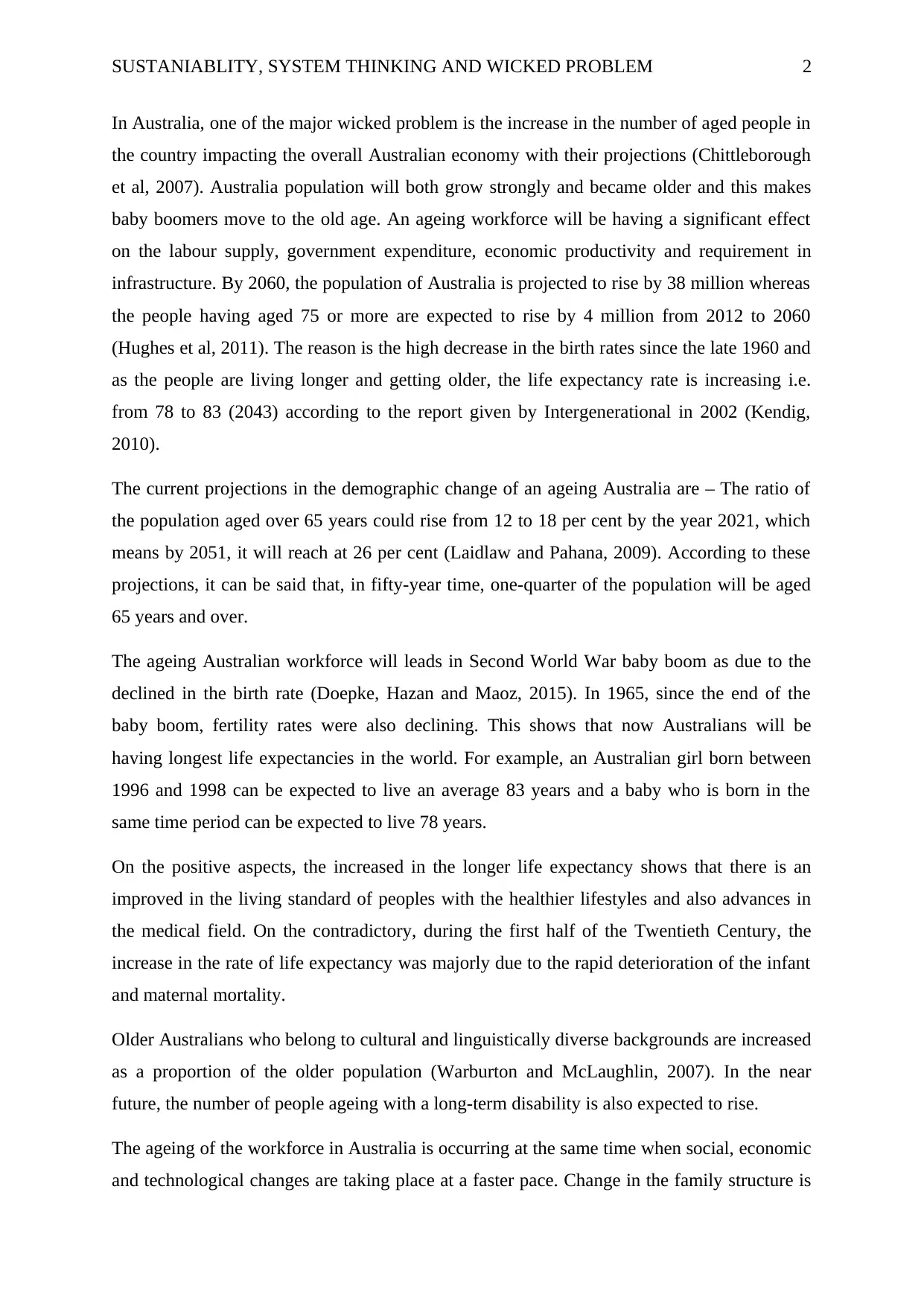
SUSTANIABLITY, SYSTEM THINKING AND WICKED PROBLEM 2
In Australia, one of the major wicked problem is the increase in the number of aged people in
the country impacting the overall Australian economy with their projections (Chittleborough
et al, 2007). Australia population will both grow strongly and became older and this makes
baby boomers move to the old age. An ageing workforce will be having a significant effect
on the labour supply, government expenditure, economic productivity and requirement in
infrastructure. By 2060, the population of Australia is projected to rise by 38 million whereas
the people having aged 75 or more are expected to rise by 4 million from 2012 to 2060
(Hughes et al, 2011). The reason is the high decrease in the birth rates since the late 1960 and
as the people are living longer and getting older, the life expectancy rate is increasing i.e.
from 78 to 83 (2043) according to the report given by Intergenerational in 2002 (Kendig,
2010).
The current projections in the demographic change of an ageing Australia are – The ratio of
the population aged over 65 years could rise from 12 to 18 per cent by the year 2021, which
means by 2051, it will reach at 26 per cent (Laidlaw and Pahana, 2009). According to these
projections, it can be said that, in fifty-year time, one-quarter of the population will be aged
65 years and over.
The ageing Australian workforce will leads in Second World War baby boom as due to the
declined in the birth rate (Doepke, Hazan and Maoz, 2015). In 1965, since the end of the
baby boom, fertility rates were also declining. This shows that now Australians will be
having longest life expectancies in the world. For example, an Australian girl born between
1996 and 1998 can be expected to live an average 83 years and a baby who is born in the
same time period can be expected to live 78 years.
On the positive aspects, the increased in the longer life expectancy shows that there is an
improved in the living standard of peoples with the healthier lifestyles and also advances in
the medical field. On the contradictory, during the first half of the Twentieth Century, the
increase in the rate of life expectancy was majorly due to the rapid deterioration of the infant
and maternal mortality.
Older Australians who belong to cultural and linguistically diverse backgrounds are increased
as a proportion of the older population (Warburton and McLaughlin, 2007). In the near
future, the number of people ageing with a long-term disability is also expected to rise.
The ageing of the workforce in Australia is occurring at the same time when social, economic
and technological changes are taking place at a faster pace. Change in the family structure is
In Australia, one of the major wicked problem is the increase in the number of aged people in
the country impacting the overall Australian economy with their projections (Chittleborough
et al, 2007). Australia population will both grow strongly and became older and this makes
baby boomers move to the old age. An ageing workforce will be having a significant effect
on the labour supply, government expenditure, economic productivity and requirement in
infrastructure. By 2060, the population of Australia is projected to rise by 38 million whereas
the people having aged 75 or more are expected to rise by 4 million from 2012 to 2060
(Hughes et al, 2011). The reason is the high decrease in the birth rates since the late 1960 and
as the people are living longer and getting older, the life expectancy rate is increasing i.e.
from 78 to 83 (2043) according to the report given by Intergenerational in 2002 (Kendig,
2010).
The current projections in the demographic change of an ageing Australia are – The ratio of
the population aged over 65 years could rise from 12 to 18 per cent by the year 2021, which
means by 2051, it will reach at 26 per cent (Laidlaw and Pahana, 2009). According to these
projections, it can be said that, in fifty-year time, one-quarter of the population will be aged
65 years and over.
The ageing Australian workforce will leads in Second World War baby boom as due to the
declined in the birth rate (Doepke, Hazan and Maoz, 2015). In 1965, since the end of the
baby boom, fertility rates were also declining. This shows that now Australians will be
having longest life expectancies in the world. For example, an Australian girl born between
1996 and 1998 can be expected to live an average 83 years and a baby who is born in the
same time period can be expected to live 78 years.
On the positive aspects, the increased in the longer life expectancy shows that there is an
improved in the living standard of peoples with the healthier lifestyles and also advances in
the medical field. On the contradictory, during the first half of the Twentieth Century, the
increase in the rate of life expectancy was majorly due to the rapid deterioration of the infant
and maternal mortality.
Older Australians who belong to cultural and linguistically diverse backgrounds are increased
as a proportion of the older population (Warburton and McLaughlin, 2007). In the near
future, the number of people ageing with a long-term disability is also expected to rise.
The ageing of the workforce in Australia is occurring at the same time when social, economic
and technological changes are taking place at a faster pace. Change in the family structure is
⊘ This is a preview!⊘
Do you want full access?
Subscribe today to unlock all pages.

Trusted by 1+ million students worldwide
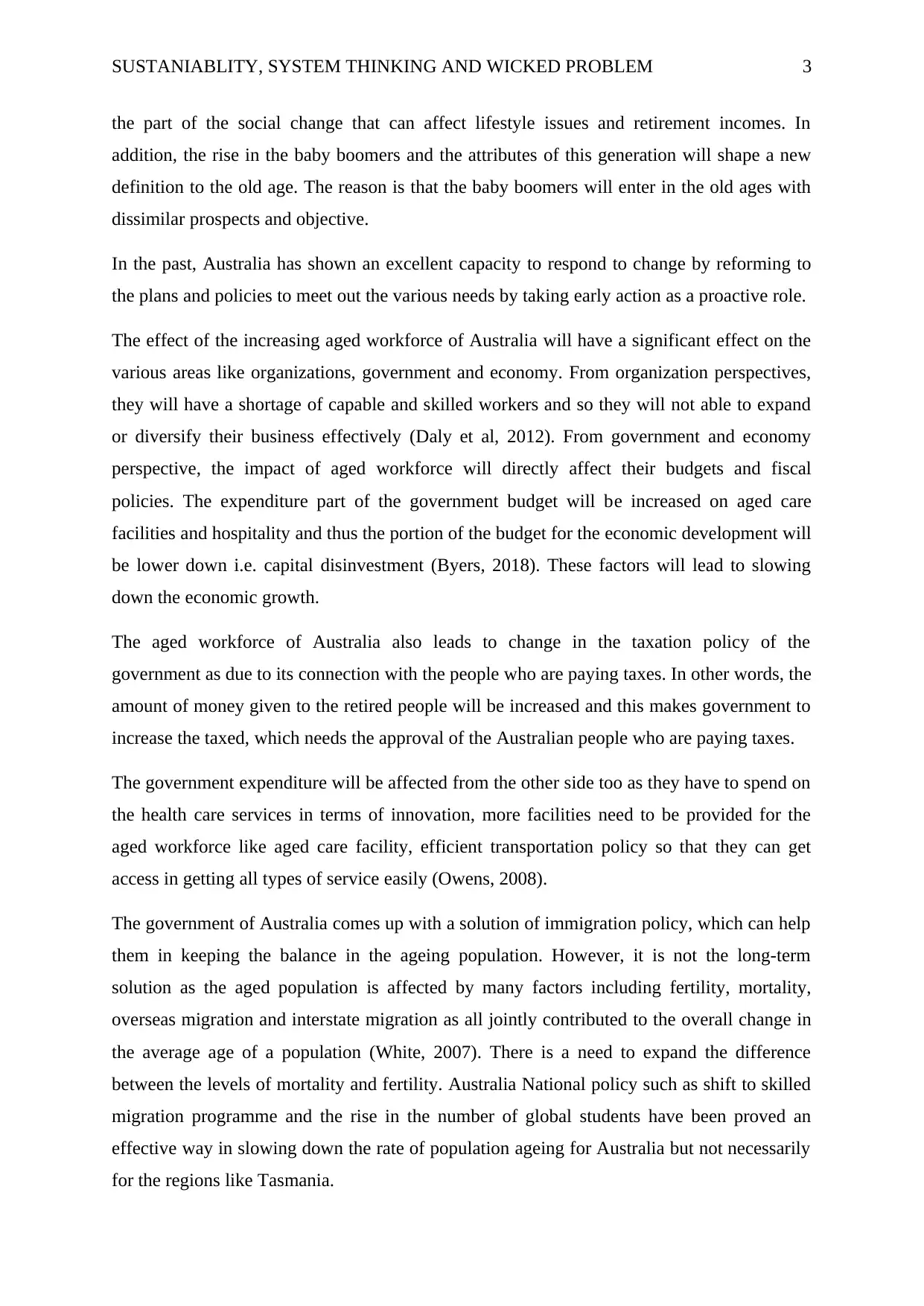
SUSTANIABLITY, SYSTEM THINKING AND WICKED PROBLEM 3
the part of the social change that can affect lifestyle issues and retirement incomes. In
addition, the rise in the baby boomers and the attributes of this generation will shape a new
definition to the old age. The reason is that the baby boomers will enter in the old ages with
dissimilar prospects and objective.
In the past, Australia has shown an excellent capacity to respond to change by reforming to
the plans and policies to meet out the various needs by taking early action as a proactive role.
The effect of the increasing aged workforce of Australia will have a significant effect on the
various areas like organizations, government and economy. From organization perspectives,
they will have a shortage of capable and skilled workers and so they will not able to expand
or diversify their business effectively (Daly et al, 2012). From government and economy
perspective, the impact of aged workforce will directly affect their budgets and fiscal
policies. The expenditure part of the government budget will be increased on aged care
facilities and hospitality and thus the portion of the budget for the economic development will
be lower down i.e. capital disinvestment (Byers, 2018). These factors will lead to slowing
down the economic growth.
The aged workforce of Australia also leads to change in the taxation policy of the
government as due to its connection with the people who are paying taxes. In other words, the
amount of money given to the retired people will be increased and this makes government to
increase the taxed, which needs the approval of the Australian people who are paying taxes.
The government expenditure will be affected from the other side too as they have to spend on
the health care services in terms of innovation, more facilities need to be provided for the
aged workforce like aged care facility, efficient transportation policy so that they can get
access in getting all types of service easily (Owens, 2008).
The government of Australia comes up with a solution of immigration policy, which can help
them in keeping the balance in the ageing population. However, it is not the long-term
solution as the aged population is affected by many factors including fertility, mortality,
overseas migration and interstate migration as all jointly contributed to the overall change in
the average age of a population (White, 2007). There is a need to expand the difference
between the levels of mortality and fertility. Australia National policy such as shift to skilled
migration programme and the rise in the number of global students have been proved an
effective way in slowing down the rate of population ageing for Australia but not necessarily
for the regions like Tasmania.
the part of the social change that can affect lifestyle issues and retirement incomes. In
addition, the rise in the baby boomers and the attributes of this generation will shape a new
definition to the old age. The reason is that the baby boomers will enter in the old ages with
dissimilar prospects and objective.
In the past, Australia has shown an excellent capacity to respond to change by reforming to
the plans and policies to meet out the various needs by taking early action as a proactive role.
The effect of the increasing aged workforce of Australia will have a significant effect on the
various areas like organizations, government and economy. From organization perspectives,
they will have a shortage of capable and skilled workers and so they will not able to expand
or diversify their business effectively (Daly et al, 2012). From government and economy
perspective, the impact of aged workforce will directly affect their budgets and fiscal
policies. The expenditure part of the government budget will be increased on aged care
facilities and hospitality and thus the portion of the budget for the economic development will
be lower down i.e. capital disinvestment (Byers, 2018). These factors will lead to slowing
down the economic growth.
The aged workforce of Australia also leads to change in the taxation policy of the
government as due to its connection with the people who are paying taxes. In other words, the
amount of money given to the retired people will be increased and this makes government to
increase the taxed, which needs the approval of the Australian people who are paying taxes.
The government expenditure will be affected from the other side too as they have to spend on
the health care services in terms of innovation, more facilities need to be provided for the
aged workforce like aged care facility, efficient transportation policy so that they can get
access in getting all types of service easily (Owens, 2008).
The government of Australia comes up with a solution of immigration policy, which can help
them in keeping the balance in the ageing population. However, it is not the long-term
solution as the aged population is affected by many factors including fertility, mortality,
overseas migration and interstate migration as all jointly contributed to the overall change in
the average age of a population (White, 2007). There is a need to expand the difference
between the levels of mortality and fertility. Australia National policy such as shift to skilled
migration programme and the rise in the number of global students have been proved an
effective way in slowing down the rate of population ageing for Australia but not necessarily
for the regions like Tasmania.
Paraphrase This Document
Need a fresh take? Get an instant paraphrase of this document with our AI Paraphraser
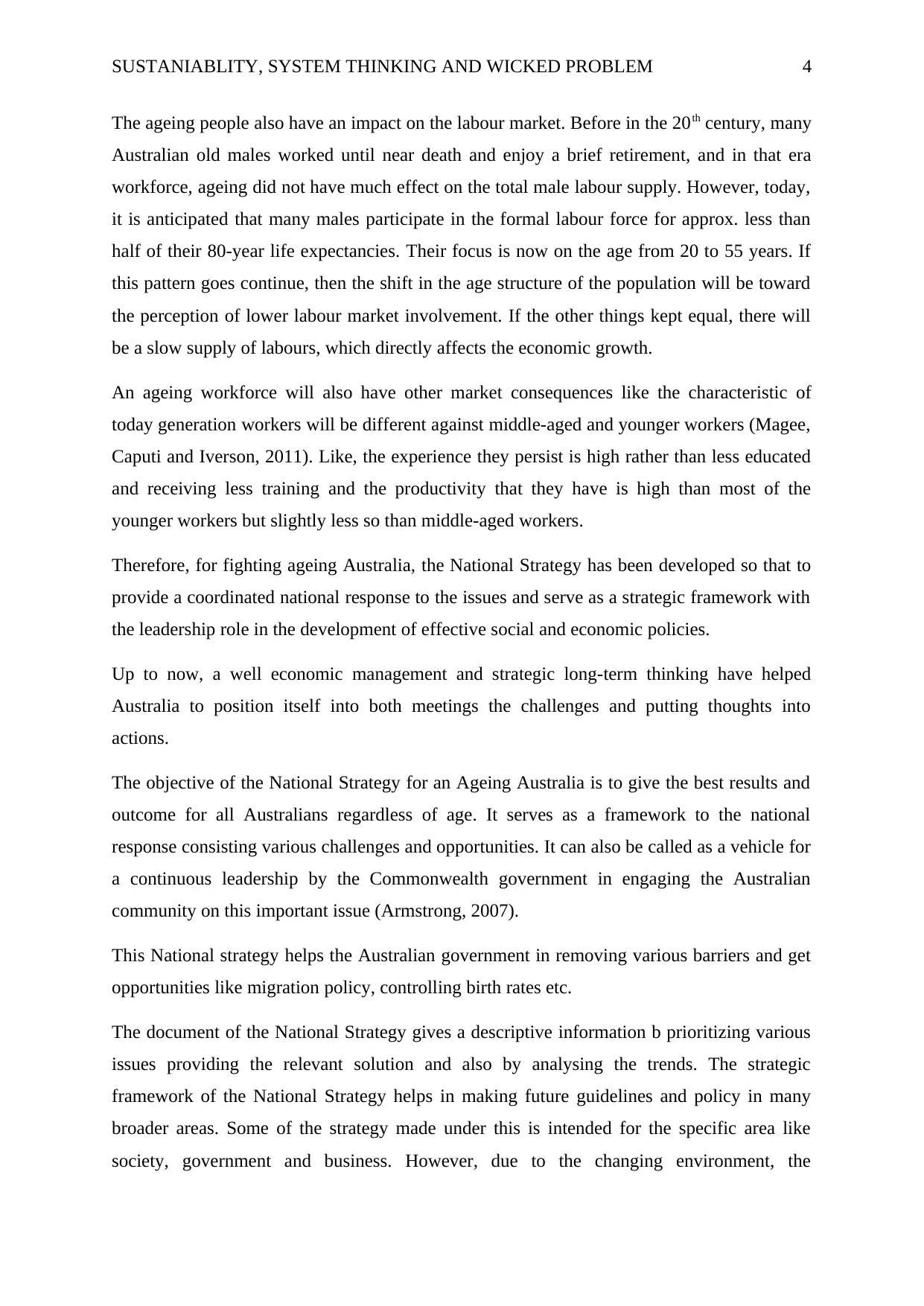
SUSTANIABLITY, SYSTEM THINKING AND WICKED PROBLEM 4
The ageing people also have an impact on the labour market. Before in the 20th century, many
Australian old males worked until near death and enjoy a brief retirement, and in that era
workforce, ageing did not have much effect on the total male labour supply. However, today,
it is anticipated that many males participate in the formal labour force for approx. less than
half of their 80-year life expectancies. Their focus is now on the age from 20 to 55 years. If
this pattern goes continue, then the shift in the age structure of the population will be toward
the perception of lower labour market involvement. If the other things kept equal, there will
be a slow supply of labours, which directly affects the economic growth.
An ageing workforce will also have other market consequences like the characteristic of
today generation workers will be different against middle-aged and younger workers (Magee,
Caputi and Iverson, 2011). Like, the experience they persist is high rather than less educated
and receiving less training and the productivity that they have is high than most of the
younger workers but slightly less so than middle-aged workers.
Therefore, for fighting ageing Australia, the National Strategy has been developed so that to
provide a coordinated national response to the issues and serve as a strategic framework with
the leadership role in the development of effective social and economic policies.
Up to now, a well economic management and strategic long-term thinking have helped
Australia to position itself into both meetings the challenges and putting thoughts into
actions.
The objective of the National Strategy for an Ageing Australia is to give the best results and
outcome for all Australians regardless of age. It serves as a framework to the national
response consisting various challenges and opportunities. It can also be called as a vehicle for
a continuous leadership by the Commonwealth government in engaging the Australian
community on this important issue (Armstrong, 2007).
This National strategy helps the Australian government in removing various barriers and get
opportunities like migration policy, controlling birth rates etc.
The document of the National Strategy gives a descriptive information b prioritizing various
issues providing the relevant solution and also by analysing the trends. The strategic
framework of the National Strategy helps in making future guidelines and policy in many
broader areas. Some of the strategy made under this is intended for the specific area like
society, government and business. However, due to the changing environment, the
The ageing people also have an impact on the labour market. Before in the 20th century, many
Australian old males worked until near death and enjoy a brief retirement, and in that era
workforce, ageing did not have much effect on the total male labour supply. However, today,
it is anticipated that many males participate in the formal labour force for approx. less than
half of their 80-year life expectancies. Their focus is now on the age from 20 to 55 years. If
this pattern goes continue, then the shift in the age structure of the population will be toward
the perception of lower labour market involvement. If the other things kept equal, there will
be a slow supply of labours, which directly affects the economic growth.
An ageing workforce will also have other market consequences like the characteristic of
today generation workers will be different against middle-aged and younger workers (Magee,
Caputi and Iverson, 2011). Like, the experience they persist is high rather than less educated
and receiving less training and the productivity that they have is high than most of the
younger workers but slightly less so than middle-aged workers.
Therefore, for fighting ageing Australia, the National Strategy has been developed so that to
provide a coordinated national response to the issues and serve as a strategic framework with
the leadership role in the development of effective social and economic policies.
Up to now, a well economic management and strategic long-term thinking have helped
Australia to position itself into both meetings the challenges and putting thoughts into
actions.
The objective of the National Strategy for an Ageing Australia is to give the best results and
outcome for all Australians regardless of age. It serves as a framework to the national
response consisting various challenges and opportunities. It can also be called as a vehicle for
a continuous leadership by the Commonwealth government in engaging the Australian
community on this important issue (Armstrong, 2007).
This National strategy helps the Australian government in removing various barriers and get
opportunities like migration policy, controlling birth rates etc.
The document of the National Strategy gives a descriptive information b prioritizing various
issues providing the relevant solution and also by analysing the trends. The strategic
framework of the National Strategy helps in making future guidelines and policy in many
broader areas. Some of the strategy made under this is intended for the specific area like
society, government and business. However, due to the changing environment, the
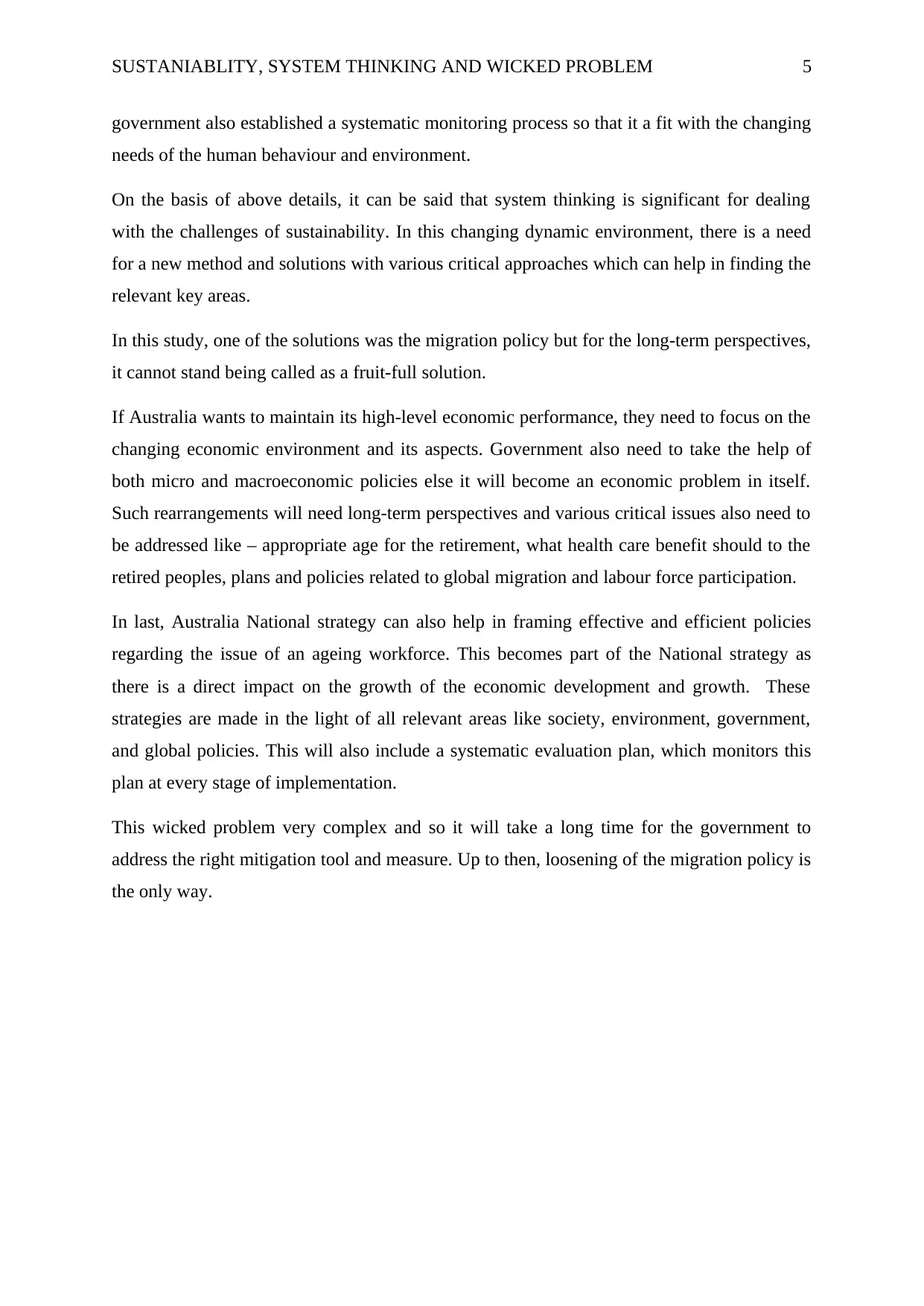
SUSTANIABLITY, SYSTEM THINKING AND WICKED PROBLEM 5
government also established a systematic monitoring process so that it a fit with the changing
needs of the human behaviour and environment.
On the basis of above details, it can be said that system thinking is significant for dealing
with the challenges of sustainability. In this changing dynamic environment, there is a need
for a new method and solutions with various critical approaches which can help in finding the
relevant key areas.
In this study, one of the solutions was the migration policy but for the long-term perspectives,
it cannot stand being called as a fruit-full solution.
If Australia wants to maintain its high-level economic performance, they need to focus on the
changing economic environment and its aspects. Government also need to take the help of
both micro and macroeconomic policies else it will become an economic problem in itself.
Such rearrangements will need long-term perspectives and various critical issues also need to
be addressed like – appropriate age for the retirement, what health care benefit should to the
retired peoples, plans and policies related to global migration and labour force participation.
In last, Australia National strategy can also help in framing effective and efficient policies
regarding the issue of an ageing workforce. This becomes part of the National strategy as
there is a direct impact on the growth of the economic development and growth. These
strategies are made in the light of all relevant areas like society, environment, government,
and global policies. This will also include a systematic evaluation plan, which monitors this
plan at every stage of implementation.
This wicked problem very complex and so it will take a long time for the government to
address the right mitigation tool and measure. Up to then, loosening of the migration policy is
the only way.
government also established a systematic monitoring process so that it a fit with the changing
needs of the human behaviour and environment.
On the basis of above details, it can be said that system thinking is significant for dealing
with the challenges of sustainability. In this changing dynamic environment, there is a need
for a new method and solutions with various critical approaches which can help in finding the
relevant key areas.
In this study, one of the solutions was the migration policy but for the long-term perspectives,
it cannot stand being called as a fruit-full solution.
If Australia wants to maintain its high-level economic performance, they need to focus on the
changing economic environment and its aspects. Government also need to take the help of
both micro and macroeconomic policies else it will become an economic problem in itself.
Such rearrangements will need long-term perspectives and various critical issues also need to
be addressed like – appropriate age for the retirement, what health care benefit should to the
retired peoples, plans and policies related to global migration and labour force participation.
In last, Australia National strategy can also help in framing effective and efficient policies
regarding the issue of an ageing workforce. This becomes part of the National strategy as
there is a direct impact on the growth of the economic development and growth. These
strategies are made in the light of all relevant areas like society, environment, government,
and global policies. This will also include a systematic evaluation plan, which monitors this
plan at every stage of implementation.
This wicked problem very complex and so it will take a long time for the government to
address the right mitigation tool and measure. Up to then, loosening of the migration policy is
the only way.
⊘ This is a preview!⊘
Do you want full access?
Subscribe today to unlock all pages.

Trusted by 1+ million students worldwide
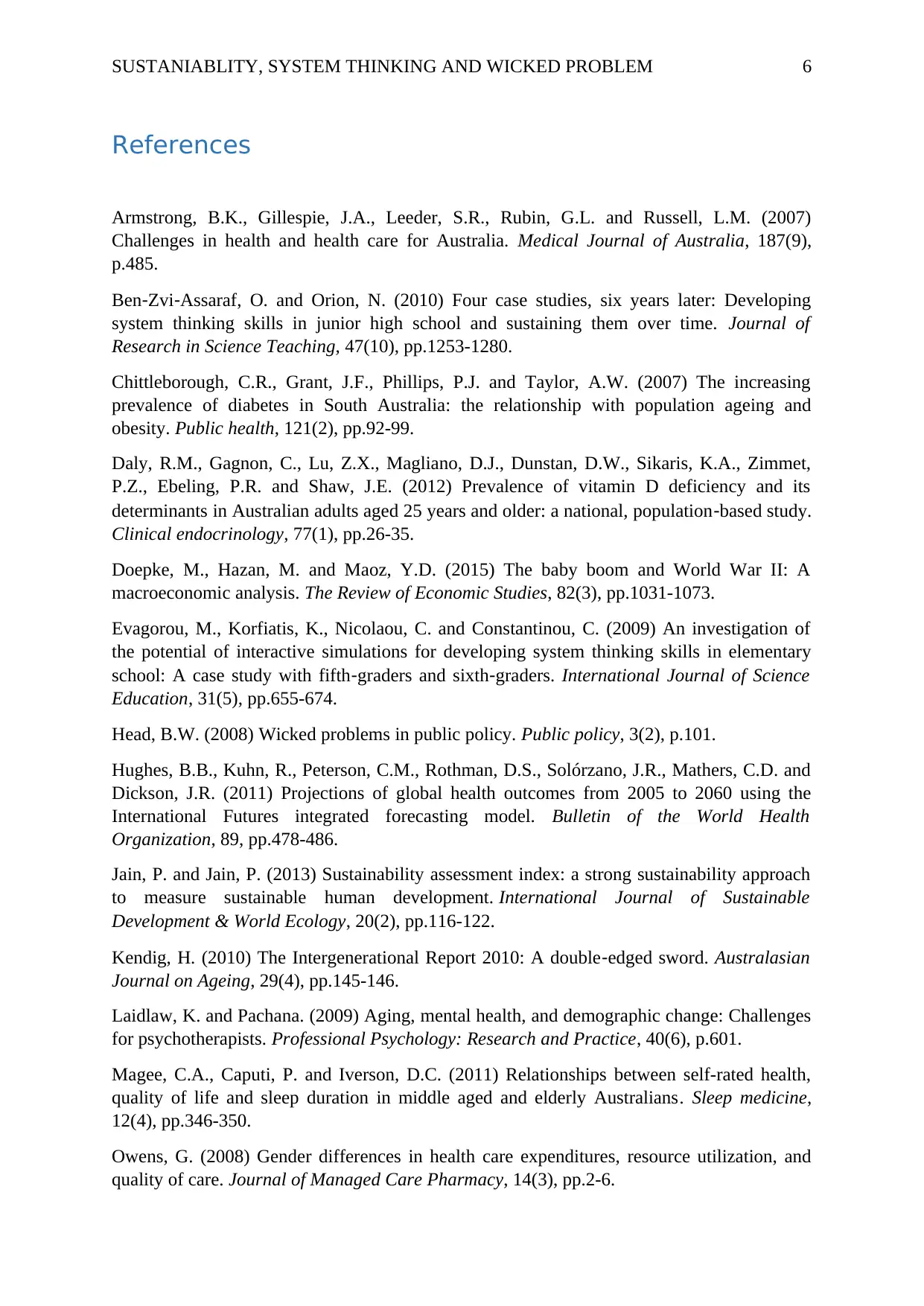
SUSTANIABLITY, SYSTEM THINKING AND WICKED PROBLEM 6
References
Armstrong, B.K., Gillespie, J.A., Leeder, S.R., Rubin, G.L. and Russell, L.M. (2007)
Challenges in health and health care for Australia. Medical Journal of Australia, 187(9),
p.485.
Ben‐Zvi‐Assaraf, O. and Orion, N. (2010) Four case studies, six years later: Developing
system thinking skills in junior high school and sustaining them over time. Journal of
Research in Science Teaching, 47(10), pp.1253-1280.
Chittleborough, C.R., Grant, J.F., Phillips, P.J. and Taylor, A.W. (2007) The increasing
prevalence of diabetes in South Australia: the relationship with population ageing and
obesity. Public health, 121(2), pp.92-99.
Daly, R.M., Gagnon, C., Lu, Z.X., Magliano, D.J., Dunstan, D.W., Sikaris, K.A., Zimmet,
P.Z., Ebeling, P.R. and Shaw, J.E. (2012) Prevalence of vitamin D deficiency and its
determinants in Australian adults aged 25 years and older: a national, population‐based study.
Clinical endocrinology, 77(1), pp.26-35.
Doepke, M., Hazan, M. and Maoz, Y.D. (2015) The baby boom and World War II: A
macroeconomic analysis. The Review of Economic Studies, 82(3), pp.1031-1073.
Evagorou, M., Korfiatis, K., Nicolaou, C. and Constantinou, C. (2009) An investigation of
the potential of interactive simulations for developing system thinking skills in elementary
school: A case study with fifth‐graders and sixth‐graders. International Journal of Science
Education, 31(5), pp.655-674.
Head, B.W. (2008) Wicked problems in public policy. Public policy, 3(2), p.101.
Hughes, B.B., Kuhn, R., Peterson, C.M., Rothman, D.S., Solórzano, J.R., Mathers, C.D. and
Dickson, J.R. (2011) Projections of global health outcomes from 2005 to 2060 using the
International Futures integrated forecasting model. Bulletin of the World Health
Organization, 89, pp.478-486.
Jain, P. and Jain, P. (2013) Sustainability assessment index: a strong sustainability approach
to measure sustainable human development. International Journal of Sustainable
Development & World Ecology, 20(2), pp.116-122.
Kendig, H. (2010) The Intergenerational Report 2010: A double‐edged sword. Australasian
Journal on Ageing, 29(4), pp.145-146.
Laidlaw, K. and Pachana. (2009) Aging, mental health, and demographic change: Challenges
for psychotherapists. Professional Psychology: Research and Practice, 40(6), p.601.
Magee, C.A., Caputi, P. and Iverson, D.C. (2011) Relationships between self-rated health,
quality of life and sleep duration in middle aged and elderly Australians. Sleep medicine,
12(4), pp.346-350.
Owens, G. (2008) Gender differences in health care expenditures, resource utilization, and
quality of care. Journal of Managed Care Pharmacy, 14(3), pp.2-6.
References
Armstrong, B.K., Gillespie, J.A., Leeder, S.R., Rubin, G.L. and Russell, L.M. (2007)
Challenges in health and health care for Australia. Medical Journal of Australia, 187(9),
p.485.
Ben‐Zvi‐Assaraf, O. and Orion, N. (2010) Four case studies, six years later: Developing
system thinking skills in junior high school and sustaining them over time. Journal of
Research in Science Teaching, 47(10), pp.1253-1280.
Chittleborough, C.R., Grant, J.F., Phillips, P.J. and Taylor, A.W. (2007) The increasing
prevalence of diabetes in South Australia: the relationship with population ageing and
obesity. Public health, 121(2), pp.92-99.
Daly, R.M., Gagnon, C., Lu, Z.X., Magliano, D.J., Dunstan, D.W., Sikaris, K.A., Zimmet,
P.Z., Ebeling, P.R. and Shaw, J.E. (2012) Prevalence of vitamin D deficiency and its
determinants in Australian adults aged 25 years and older: a national, population‐based study.
Clinical endocrinology, 77(1), pp.26-35.
Doepke, M., Hazan, M. and Maoz, Y.D. (2015) The baby boom and World War II: A
macroeconomic analysis. The Review of Economic Studies, 82(3), pp.1031-1073.
Evagorou, M., Korfiatis, K., Nicolaou, C. and Constantinou, C. (2009) An investigation of
the potential of interactive simulations for developing system thinking skills in elementary
school: A case study with fifth‐graders and sixth‐graders. International Journal of Science
Education, 31(5), pp.655-674.
Head, B.W. (2008) Wicked problems in public policy. Public policy, 3(2), p.101.
Hughes, B.B., Kuhn, R., Peterson, C.M., Rothman, D.S., Solórzano, J.R., Mathers, C.D. and
Dickson, J.R. (2011) Projections of global health outcomes from 2005 to 2060 using the
International Futures integrated forecasting model. Bulletin of the World Health
Organization, 89, pp.478-486.
Jain, P. and Jain, P. (2013) Sustainability assessment index: a strong sustainability approach
to measure sustainable human development. International Journal of Sustainable
Development & World Ecology, 20(2), pp.116-122.
Kendig, H. (2010) The Intergenerational Report 2010: A double‐edged sword. Australasian
Journal on Ageing, 29(4), pp.145-146.
Laidlaw, K. and Pachana. (2009) Aging, mental health, and demographic change: Challenges
for psychotherapists. Professional Psychology: Research and Practice, 40(6), p.601.
Magee, C.A., Caputi, P. and Iverson, D.C. (2011) Relationships between self-rated health,
quality of life and sleep duration in middle aged and elderly Australians. Sleep medicine,
12(4), pp.346-350.
Owens, G. (2008) Gender differences in health care expenditures, resource utilization, and
quality of care. Journal of Managed Care Pharmacy, 14(3), pp.2-6.
Paraphrase This Document
Need a fresh take? Get an instant paraphrase of this document with our AI Paraphraser
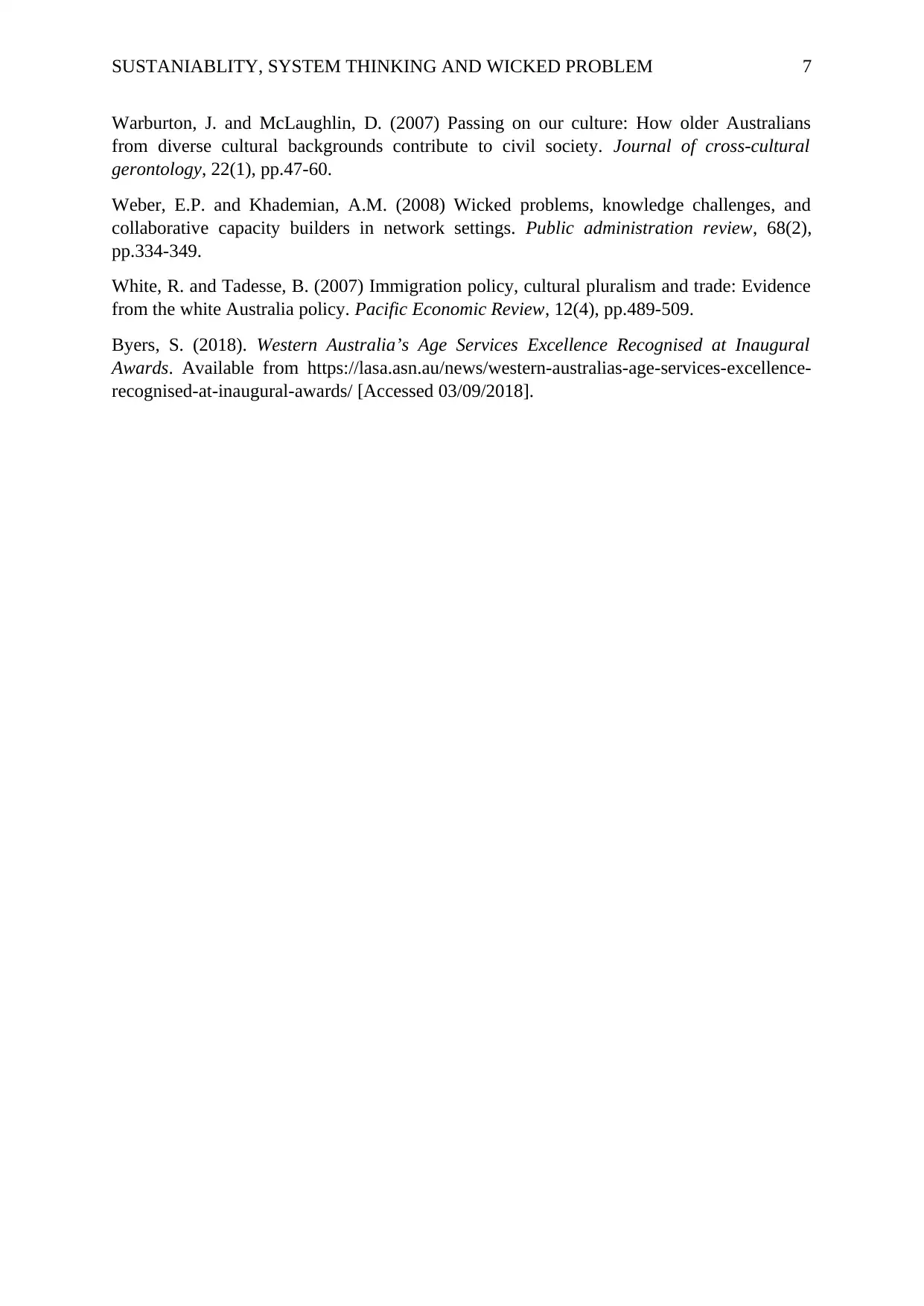
SUSTANIABLITY, SYSTEM THINKING AND WICKED PROBLEM 7
Warburton, J. and McLaughlin, D. (2007) Passing on our culture: How older Australians
from diverse cultural backgrounds contribute to civil society. Journal of cross-cultural
gerontology, 22(1), pp.47-60.
Weber, E.P. and Khademian, A.M. (2008) Wicked problems, knowledge challenges, and
collaborative capacity builders in network settings. Public administration review, 68(2),
pp.334-349.
White, R. and Tadesse, B. (2007) Immigration policy, cultural pluralism and trade: Evidence
from the white Australia policy. Pacific Economic Review, 12(4), pp.489-509.
Byers, S. (2018). Western Australia’s Age Services Excellence Recognised at Inaugural
Awards. Available from https://lasa.asn.au/news/western-australias-age-services-excellence-
recognised-at-inaugural-awards/ [Accessed 03/09/2018].
Warburton, J. and McLaughlin, D. (2007) Passing on our culture: How older Australians
from diverse cultural backgrounds contribute to civil society. Journal of cross-cultural
gerontology, 22(1), pp.47-60.
Weber, E.P. and Khademian, A.M. (2008) Wicked problems, knowledge challenges, and
collaborative capacity builders in network settings. Public administration review, 68(2),
pp.334-349.
White, R. and Tadesse, B. (2007) Immigration policy, cultural pluralism and trade: Evidence
from the white Australia policy. Pacific Economic Review, 12(4), pp.489-509.
Byers, S. (2018). Western Australia’s Age Services Excellence Recognised at Inaugural
Awards. Available from https://lasa.asn.au/news/western-australias-age-services-excellence-
recognised-at-inaugural-awards/ [Accessed 03/09/2018].
1 out of 8
Related Documents
Your All-in-One AI-Powered Toolkit for Academic Success.
+13062052269
info@desklib.com
Available 24*7 on WhatsApp / Email
![[object Object]](/_next/static/media/star-bottom.7253800d.svg)
Unlock your academic potential
Copyright © 2020–2025 A2Z Services. All Rights Reserved. Developed and managed by ZUCOL.




